Cloud seeding challenges our understanding of global warming
Loading...
Global warming is a contentious subject, and the climate models used by the Intergovernmental Panel on Climate Change (IPCC) to predict future changes are, by their very nature, based on the best estimates according to current scientific understanding.
One of the essential factors considered by these models is the role of clouds, as the cloudier our skies – or the whiter the clouds – the more sunlight is reflected back into space, which has a cooling effect on our planet.
Up until now, scientists had believed that the aerosols pumped into the atmosphere had caused clouds to be much whiter than in preindustrial times, having a cooling effect and masking some of the impacts of anthropogenic activity. But new research, published concurrently in three separate papers, suggests that clouds may have changed little, with implications for our understanding of global warming.
"It's a complicated issue," says Neil Donahue of Carnegie Mellon University, coauthor on two of the papers, in a phone interview with The Christian Science Monitor, "and this work is dealing with uncertainty, dealing with the limits of our understanding, rather than turning our understanding upside down."
It all begins with the fundamentals of cloud formation.
Water vapor alone cannot form clouds. In order for clouds to form, water droplets require other particles in the atmosphere, around which they can coalesce. Up until this recent research, it was thought that sulphuric acid was integral to that process.
Sulphuric acid finds its way into the atmosphere through two main processes: volcanic activity and the burning of fossil fuels.
With this in mind, it was generally believed that cloud formation would have been different in preindustrial times, when no fossil fuels were being incinerated. Specifically, this hypothesis doesn't imply there are more clouds today, but that they are whiter – with more particles for the water to form around, more droplets would have formed in each cloud, making them more reflective.
"Has that cloud brightness changed in the past 250 years?" asks Dr. Donahue. "If they're now significantly whiter than in 1750 – by definition, the preindustrial era – that means this cloud effect has been cooling, with more sunlight being reflected. It would counteract some of the warming taking place because of increased carbon dioxide."
Here is the crux: Built into scientific climate models has been the assumption that the temperature rise our planet is experiencing has been masked somewhat by increased reflectivity of the clouds.
But what if cloud reflectivity had, in fact, barely changed at all?
And that is exactly what these three studies indicate. Using two entirely different methods, the researchers have found that trees themselves are capable of producing molecules that act in the same way as sulphuric acid, able to form that basic structure around which clouds can form.
More, they hypothesize that trees may even regulate the amount of such molecules that they emit, in an effort to regulate climate, in keeping with the Gaia hypothesis.
All of which implies that cloud reflectivity may have changed little since preindustrial times. But the implications of that conclusion are complex and require an understanding of the different factors comprising global warming.
"We know the Earth is about 0.8 degrees Celsius warmer now than it was in the preindustrial era," says Donahue. "But global warming has two constituents: forcing and sensitivity. Forcing is how hard we're pushing; sensitivity is, essentially, if I push a certain amount, how much warmer will it get?"
It's like an equation: If the change has been 0.8 degrees, then if one of these two factors diminishes, the other has to rise.
What these recent experiments reveal is that forcing has been more intense than previously believed. Forcing relates specifically to how much heat is reaching the Earth's surface: By spewing carbon dioxide and other greenhouse gases into the atmosphere, it forms something of a "blanket," which holds in that heat; conversely, more reflective clouds diminish the amount of heat reaching the surface in the first place, having a cooling effect.
So, if the cooling effect of clouds has not increased as previously concluded, then it follows that climate sensitivity is also less. The models of the IPCC have assumed climate sensitivity (specifically the increase in global temperature resulting from a doubling of preindustrial levels of carbon dioxide) to be between 2 to 5 degrees Celsius.
"So, it now seems less likely that sensitivity is at the high end of that range," explains Donahue. "But this impacts our understanding within that range, rather than giving us something totally new."
This research provides one more factor to feed into the IPCC's climate models in the ever-evolving understanding of anthropogenic global warming. The work was published Thursday in Nature (considering initial particle growth in the atmosphere and ion-induced nucleation) and Science (new particle formation in the free troposphere).








